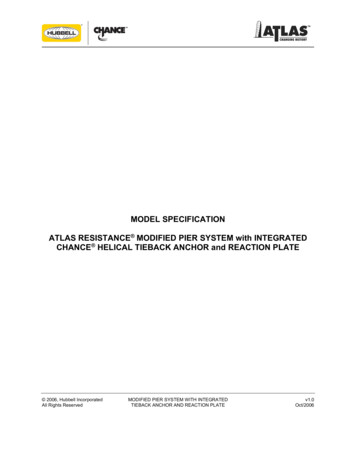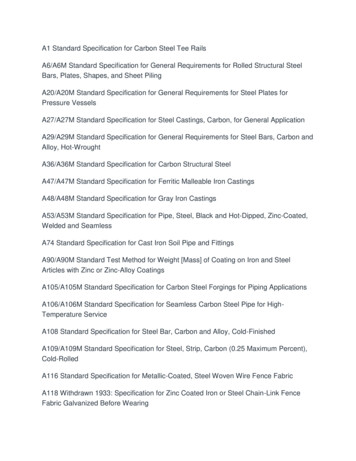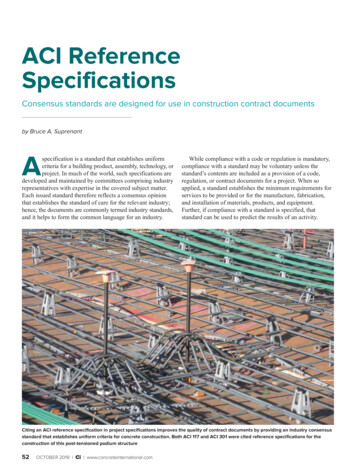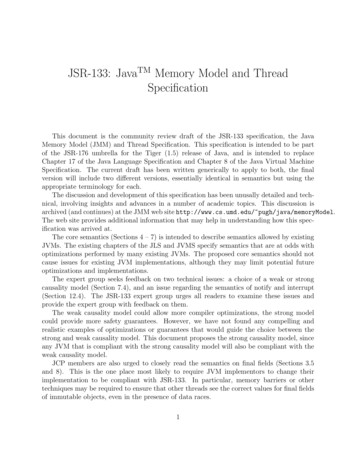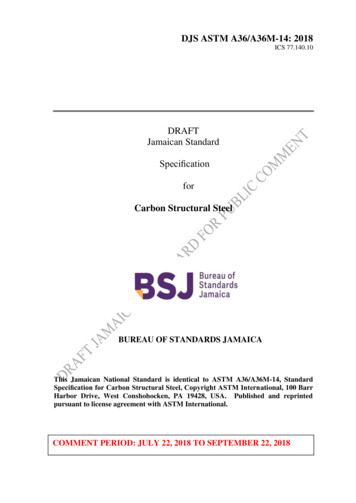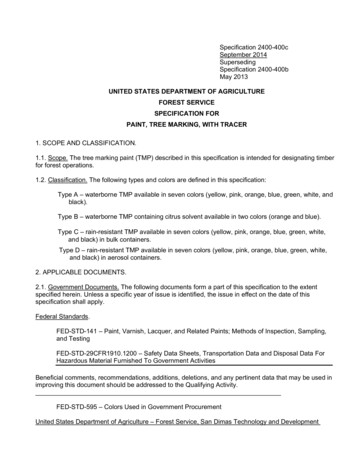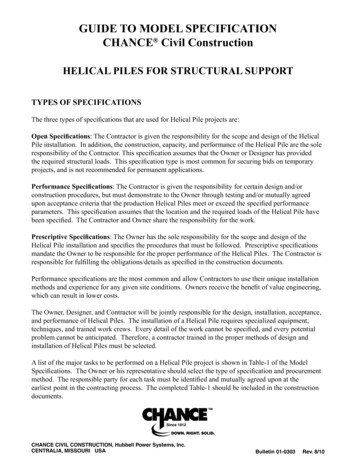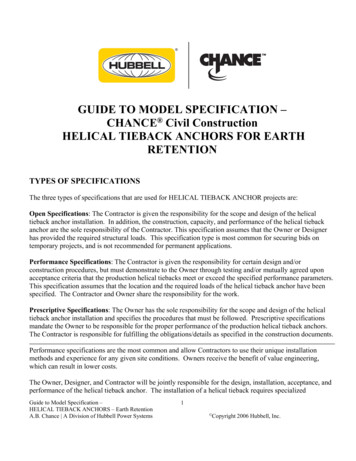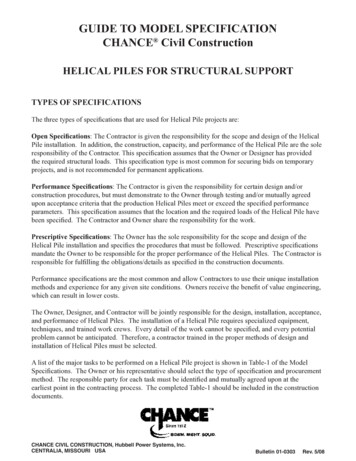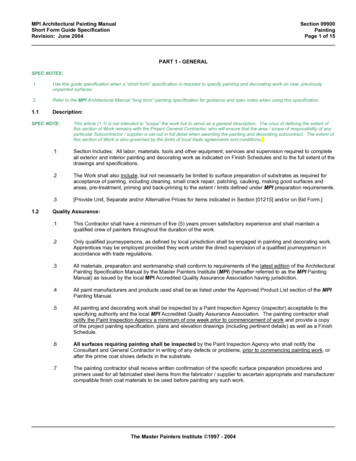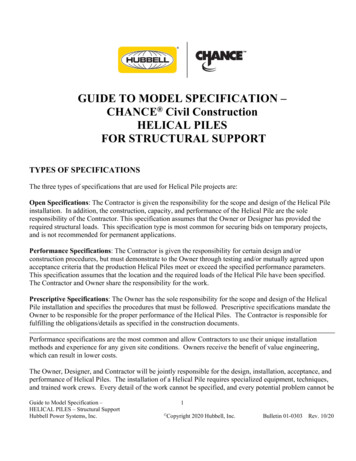
Transcription
GUIDE TO MODEL SPECIFICATION –CHANCE Civil ConstructionHELICAL PILESFOR STRUCTURAL SUPPORTTYPES OF SPECIFICATIONSThe three types of specifications that are used for Helical Pile projects are:Open Specifications: The Contractor is given the responsibility for the scope and design of the Helical Pileinstallation. In addition, the construction, capacity, and performance of the Helical Pile are the soleresponsibility of the Contractor. This specification assumes that the Owner or Designer has provided therequired structural loads. This specification type is most common for securing bids on temporary projects,and is not recommended for permanent applications.Performance Specifications: The Contractor is given the responsibility for certain design and/orconstruction procedures, but must demonstrate to the Owner through testing and/or mutually agreed uponacceptance criteria that the production Helical Piles meet or exceed the specified performance parameters.This specification assumes that the location and the required loads of the Helical Pile have been specified.The Contractor and Owner share the responsibility for the work.Prescriptive Specifications: The Owner has the sole responsibility for the scope and design of the HelicalPile installation and specifies the procedures that must be followed. Prescriptive specifications mandate theOwner to be responsible for the proper performance of the Helical Piles. The Contractor is responsible forfulfilling the obligations/details as specified in the construction documents.Performance specifications are the most common and allow Contractors to use their unique installationmethods and experience for any given site conditions. Owners receive the benefit of value engineering,which can result in lower costs.The Owner, Designer, and Contractor will be jointly responsible for the design, installation, acceptance, andperformance of Helical Piles. The installation of a Helical Pile requires specialized equipment, techniques,and trained work crews. Every detail of the work cannot be specified, and every potential problem cannot beGuide to Model Specification –HELICAL PILES – Structural SupportHubbell Power Systems, Inc.1 Copyright 2020 Hubbell, Inc.Bulletin 01-0303Rev. 10/20
anticipated. Therefore, a contractor trained in the proper methods of design and installation of Helical Pilesmust be selected.A list of the major tasks to be performed on a Helical Pile project is shown in Table-1 of the ModelSpecifications. The Owner or his representative should select the type of specification and procurementmethod. The responsible party for each task must be identified and mutually agreed upon at the earliest pointin the contracting process. The completed Table-1 should be included in the construction documents.The process of continuous communication between all the parties involved is essential to achieve asatisfactory result. Clear communication and close cooperation are particularly important in the start-upphase and in testing. In addition, a timely preparation and review of all submittals is critical.This model specification can be adapted to each of the three types of specifications. However, it is primarilywritten for the performance type. The identity of the “Contractor” and the “Owner” is always well defined,unlike that of the “Designer” or “Engineer”. For example, the “Engineer” may be an employee(s) of theContractor, or a third-party consultant hired to secure a lower cost alternative during the bidding process. Incontrast, the “Engineer” may be the Owner, an employee(s) of the Owner, or a representative hired by theOwner. It is recommended that the Engineer be a third-party agency employed by the Owner to serve in theowner’s best interests during the various stages of the contract.For purposes of this Model Specification, the subject is a high capacity Helical Pile manufactured byCHANCE Civil Construction. At present, maximum working or design loads range between 12.5 and 50tons. The Helical Pile consists of one or more helical bearing plates attached at the tip of a high strengthcentral steel shaft. The central steel shaft consists of either a solid square shaft of various sizes, or hollowpipe shaft of various diameters and wall thickness. The steel shafts are typically 1-1/2” to 8 inches indiameter and will accept load directly axially and/or laterally to provide structural support.It is suggested that the specification writer accurately andcompletely modify this model to suit his/her particular case.Items in italics as such may be considered as “Commentary” and as such may be deleted or retained to suitthe needs of the specification writer.Guide to Model Specification –HELICAL PILES – Structural SupportHubbell Power Systems, Inc.2 Copyright 2020 Hubbell, Inc.Bulletin 01-0303Rev. 10/20
The following is list of general references that will provide additional background to Helical Pile technology:Goen, J. Lee, Compression Load on HELICAL PIER Foundation Systems Anchors – Design andConstruction, Bulletin 01-9304, Copyright 1998 Hubbell/Chance, 210 North Allen St., Centralia, MO 65240Hargrave, R. L. and Thorsten, R. E., 1992. Helical Piers in Expansive Soils of Dallas, Texas. Proceedings 7thInternational Conference on Expansive Soils, Session 24, Bulletin 01-9311, Copyright 1993 A. B. Chance,210 North Allen St., Centralia, MO 65240Hoyt, R.M. and Clemence, S.P., 1989. Uplift Capacity of Helical Anchors in Soil. Proceedings of the 12thInternational Conference on Soil Mechanics and Foundation Engineering, Vol. 2, pp. 1019-1022.Hubbell Power Systems, Inc., Technical Design Manual – 4th Edition, Copyright 2018, Hubbell Inc., 210North Allen St., Centralia, MO 65240“ICC-ES ESR-2794”, Reissued April 2019, ICC Evaluation Service, Inc., Brea, CA 92821Lutenegger, Alan J., Gary L. Seider, “Profiling Subsurface Stratigraphy Using Torque Measurements fromInstallation of a Helical Plate”, Proceedings, ISC’4, Fourth International Conference on Geotechnical andGeophysical Site Characterization, September 18 – 21, 2012 Porto de Galinhas, Pernambuco, Brazil.Pack, J. S., 2000. Design of Helical Piles for Heavily Loaded Structures. New Technological and DesignDevelopments in Deep Foundations, ASCE Geotechnical Special Publication, pp. 353- 367.Seider, Gary L., “Versatile Steel Screw Anchors”, Structural Engineer Magazine, March 2000; Volume 1,Number 2, ppgs. 42-46.Seider, Gary L. (2015), “Bearing and Friction Design Capacity Software for Helical Anchors and Piles”,Proceedings, The 2015 International Foundations Congress & Equipment Exposition (IFCEE), San Antonio,TXWesolek, Dana A., Schmednecht, Fred C., and Seider, Gary L. “Helical Piers/Anchors in the Chicago BuildingCode”, Proceedings of the DFI 30th Annual Conference on Deep Foundations, Chicago, IL pp. 193-204.Guide to Model Specification –HELICAL PILES – Structural SupportHubbell Power Systems, Inc.3 Copyright 2020 Hubbell, Inc.Bulletin 01-0303Rev. 10/20
CHANCE Civil ConstructionHELICAL PILESMODEL SPECIFICATION1. GENERAL1.1 Purpose of SpecificationThe purpose of this specification is to detail the furnishing of all designs, materials, tools, equipment, laborand supervision, and installation techniques necessary to install Helical Piles as detailed on the drawings,including connection details. This shall include provisions for load testing that may be part of the scope ofworkSpecifier Note: This specification may require modification to account for unusual and/or unforeseen siteand subsurface conditions and the particular circumstances of the project.1.2 Scope of WorkThis work consists of furnishing all necessary engineering and design services (if required), supervision,labor, tools, materials, and equipment to perform all work necessary to install the Helical Piles, at (location,City, State/Province) for (Company, State or Private Authority) per the specifications described herein, andas shown on the drawings. The Contractor shall install a Helical Pile that will develop the load capacities asdetailed on the drawings. This may also include provisions for load testing to verify Helical Pile capacityand deflection, if part of the scope of work. The responsibilities and duties of the respective parties for thisproject are summarized in Table-1.Guide to Model Specification –HELICAL PILES – Structural SupportHubbell Power Systems, Inc.4 Copyright 2020 Hubbell, Inc.Bulletin 01-0303Rev. 10/20
Table-1. Tasks and Responsibilities to be Allocated for Helical Pile Y*Site Investigation, Geotechnical Investigation, Site Survey, and potentialwork restrictionsType of specification, requirement for a pre-contract testing program, andprocurement methodObtaining easementsOverall scope of work, design of the Helical Pile structure – includingdesign loads (vertical, horizontal, etc.), pile locations, and pile spacingand orientationDefinition and qualification of safety factorsCalculation/estimation of allowable structural and/or Helical Pilemovement in service (acceptance criteria)Definition of service life (temporary – months or permanent - years) andrequired degree of corrosion protection based on site conditionsType and number of tests (pre-contract, pre-production and production)Minimum total Helical Pile length, depth to bearing stratumHelical Pile components and detailsDetails of corrosion protection, if requiredDetails of pile connection to structure (e.g., for static and seismicconditions)Preparation of Drawings and test reportsEvaluation of test resultsConstruction methods, schedule, sequencing, and coordination of workRequirements of field production control, including logging of installationtorque vs. installed depthSupervision of workLong-term monitoring* To be filled in by specification writer.1.3 Qualifications of the Helical Pile ContractorThe Helical Pile Contractor shall be experienced in performing design and construction of Helical Piles andshall furnish all materials, labor, and supervision to perform the work. The Contractor shall be trained andauthorized by Hubbell Power Systems, Inc. in the proper methods of design and installation of Helical Piles.The Contractor shall provide names of on-site personnel materially involved with the work, including thosewho carry documented certification from Hubbell Power Systems, Inc. At a minimum, these personnel shallinclude foreman, machine operator, and project engineer/manager.The Helical Pile Contractor shall not sublet the whole or any part of the contract without the express writtenpermission of the Owner.Guide to Model Specification –HELICAL PILES – Structural SupportHubbell Power Systems, Inc.5 Copyright 2020 Hubbell, Inc.Bulletin 01-0303Rev. 10/20
1.4 Related Project SpecificationsTo be determined by the specification writer.1.5 DefinitionsA partial list follows. The Owner may wish to add other specific, project-related items.Contractor: The person/firm responsible for performing the Helical Pile work.Coupling: Central steel shaft connection means formed as integral part of the plain extension shaft material.For Type SS & RS Helical Piles, couplings are internal or external sleeves, or hot upset forged sockets.Coupling Bolt(s): High strength, structural steel fasteners used to connect Helical Pile segments together.For Type SS segments, the coupling bolt transfers axial load. For Type RS segments, the coupling boltstransfer both axial and torsional forces.Helical Extension: Helical Pile foundation component installed immediately following the lead or startersection, if required. This component consists of one or more helical plates welded to a central steel shaft offinite length. Function is to increase bearing area.Helix Plate: Generally round steel plate formed into a ramped spiral. The helical shape provides the meansto install the helical pile, plus the plate transfers load to soil in end bearing. Helix plates are available invarious diameters and thickness.HELICAL PULLDOWN Micropile: A small diameter, soil displacement, cast-in-place Helical Pile, inwhich most of the applied load is resisted by the central steel shaft and steel reinforcement, if installed. Loadtransfer to soil is both end bearing and friction. United States Patent 5,707,180, Method and Apparatus forForming Piles In-Situ. A.k.a. HPM.Helical Pile: A bearing type foundation element consisting of a lead or starter section, helical extension (ifso required by site conditions), plain extension section(s), and a pile cap. A.k.a. helical screw pile, screwpile, helical screw foundation.Installation Torque(T): The resistance generated by a Helical Pile when installed into soil. The installationresistance is a function of the soil type, and size and shape of the various components of the Helical Pile.Lead Section: The first Helical Pile foundation component installed into the soil, consisting of single ormultiple helix plates welded to a central steel shaft. A.k.a. Starter Section.Pile Cap: Connection means by which structural loads are transferred to the Helical Pile. The type ofconnection varies depending upon the requirements of the project and type of Helical Pile material used.Guide to Model Specification –HELICAL PILES – Structural SupportHubbell Power Systems, Inc.6 Copyright 2020 Hubbell, Inc.Bulletin 01-0303Rev. 10/20
Round Shaft (RS): Round steel pipe central Shaft elements ranging in diameter from 2-7/8” to 10”. A.k.a.Hollow Shaft (Type HS), Type T/C, Type PIF.Plain Extension: Central steel shaft segment without helix plates. It is installed following the installation ofthe lead section or helical extension (if used). The segments are connected with integral couplings and bolts.Plain extensions are used to extend the helix plates beyond the specified minimum depth and into competentload bearing stratum.Safety Factor: The ratio of the ultimate capacity to the working or design load used for the design of anystructural element.Square Shaft (SS): Solid steel, round-cornered-Square central Shaft elements ranging in size from 1-1/4” to2-1/4”. A.k.a. Type SQ.Torque Strength Rating: The maximum torque energy that can be applied to the helical pile foundationduring installation in soil, a.k.a. allowable, or safe torque.1.6 Allowable TolerancesThe tolerances quoted in this section are suggested maximums. The actual values established for a particularproject will depend on the structural application.1.6.1Centerline of Helical Piles shall not be more than 3 inches from indicated plan location.1.6.2Helical Pile plumbness shall be within 2 of design alignment.1.6.3Top elevation of Helical Pile shall be within 1 inch to –2 inches of the design vertical elevation.1.7 Quality Assurance1.7.1Helical Piles shall be installed by authorized Hubbell Power Systems, Inc. Contractor. TheseContractors shall have satisfied the requirements relative to the technical aspects of the product andinstallation procedures as therein specified. Authorization documents shall be provided upon requestto the Owner or their representative.1.7.2The Contractor shall employ an adequate number of skilled workers who are experienced in thenecessary crafts and who are familiar with the specified requirements and methods needed for properperformance of the work of this specification.1.7.3All Helical Piles shall be installed in the presence of a designated representative of the Owner unlesssaid representative informs the Contractor otherwise. The designated representative shall have theright of access to any and all field installation records and test reports.Guide to Model Specification –HELICAL PILES – Structural SupportHubbell Power Systems, Inc.7 Copyright 2020 Hubbell, Inc.Bulletin 01-0303Rev. 10/20
1.7.4Helical Pile components as specified therein shall be manufactured by a facility whose qualitysystems comply with ISO (International Organization of Standards) 9001 requirements. Certificatesof Registration denoting ISO Standards Number shall be presented upon request to the Owner or theirrepresentative.1.7.5Hubbell Power Systems, Inc. provides a 30-year Peace of Mind warranty on materials andworkmanship of the product installed by a certified contractor. Any additional warranty provided bythe Contractor shall be issued as an addendum to this specification.1.7.6Design of Helical Piles shall be performed by an entity as required in accordance with existing localcode requirements or established local practices. This design work may be performed by a licensedprofessional Engineer, an authorized Hubbell Power Systems, Inc. Contractor, or Designer dependingupon local requirements or practices.1.8 Design Criteria1.8.1Helical Piles shall be designed to meet the specified loads and acceptance criteria as shown on thedrawings. The calculations and drawings required from the Contractor or Engineer shall besubmitted to the Owner for review and acceptance in accordance to Section 3.1 “ConstructionSubmittals”.1.8.2The allowable working load on the Helical Piles shall not exceed the following mechanical strengthvalues:1.8.2.1 For compression loads:Pallowc 0.6 * fyshaft * AshaftWhere: Pallowc allowable working load in compression (kip)fyshaft minimum yield strength of central steel shaft (ksi)Ashaft area of central steel shaft (with corrosion allowance if required) (in.2)The minimum yield strength of the central steel shaft is as follows: Type SS5: 70 ksi; Type SS125,SS150, SS175, SS200, SS225: 90 ksi; Type RS2875, RS3500, RS4500: 50 ksi.The allowable working loads may be reduced by the allowable load capacity per helix plate(s) andthe allowable load capacity based on soil type and pile-head end condition. It is recommended to usethe allowable load capacities per helical pile type as published by Hubbell Power Systems, Inc.(shown in Section 7 of the Technical Design Manual – 4th Edition).1.8.2.2 For tension loads:Pallowt Sut / FSGuide to Model Specification –HELICAL PILES – Structural SupportHubbell Power Systems, Inc.8 Copyright 2020 Hubbell, Inc.Bulletin 01-0303Rev. 10/20
Where: Pallowt allowable working load in tension (kip)Sut Min. ultimate tensile strength of central steel shaft segment (at coupling joint) (kip)FS factor of safety suitable for application, i.e. temporary or permanent structuresFor permanent applications, it is recommended to use a factor of safety of two (2). For temporaryapplications, factor of safety typically ranges between 1.25 and 1.5.The tension strength may be reduced by the ultimate strength per helix plate(s) – depending on thenumber of helix plates specified and type of shaft family used. The ultimate tension strength may alsobe reduced by the torque correlated capacity – depending on the type of shaft family used. It isrecommended to use the tension strengths as published by Hubbell Power Systems, Inc. (shown inSection 7 of the Technical Design Manual – 4th Edition)1.8.3Except where noted otherwise on the project plans, all helical piles shall be designed and installed toprovide a minimum safety factor for ultimate applied load of (2.0 typical), and a maximumaxial displacement at working load of (1 inch [25 mm] typical). The Owner shall determinethe allowable response to axial loads based on serviceability requirements.1.8.4Helical Pile capacity in soil shall not be relied upon from the following soil layers as defined in thegeotechnical reports:The overall length and installed torque of a Helical Pile shall be specified such that the required insoil capacity is developed by end-bearing on the helix plate(s) in an appropriate strata(s).It is recommended that the theoretical end-bearing capacity of the helix plates be determined usingHeliCAP Engineering Software or equal commercially available software. The required soilparameters (c, , , or N-values) for use with HeliCAP or equal shall be provided in the geotechnicalreports.Helical Piles are not suited for solid, competent rock, but the helix plates can penetrate into densebearing soils. It is recommended that Helical Piles be installed to a specified minimum torque anddepth to ensure the helical plates are terminated in bearing soils. Appropriate and repeatableinstallation techniques and Helical Pile termination criteria must be identified and verified in thefield.1.8.5Lateral Load and Bending: Where Helical Piles are subjected to lateral or base shear loads asindicated on the plans, the bending moment from said loads shall be determined using lateral loadanalysis program such as LPILE or equal commercially available software. The required soilparameters (c, , , and ks) for use with LPILE or equal shall be provided in the geotechnical reports.The Owner shall determine the allowable response to lateral loads based on serviceabilityGuide to Model Specification –HELICAL PILES – Structural SupportHubbell Power Systems, Inc.9 Copyright 2020 Hubbell, Inc.Bulletin 01-0303Rev. 10/20
requirements. The combined bending and axial load factor of safety of the Helical Pile shall be asdetermined by the Owner.CHANCE Helical Piles are slender foundation elements, i.e. the shafts range from 1-1/4” to 4-1/2”in diameter. As such, vertically installed Helical Piles generally require enlarged shaft sections orpile caps to adequately resist lateral load. The lateral load analysis as detailed in Section 1.8.5 ofthe specification can be used to determine the required diameter and length of the enlarged shaftsection or pile cap.It is recommended to list below each load combination and required factor of safety for this specificproject.1.8.6Critical Buckling Load: Where Helical Piles are installed into low strength soil, the critical bucklingload shall be determined using lateral load analysis program such as LPILE or equal commerciallyavailable software, or various other methods. The required soil parameters (c, , , and ks) for usewith LPILE or equal shall be provided in the geotechnical reports.Research shows that buckling, either elastic or nonelastic, is of practical concern only for longHelical Pile shafts in the softest soils. This is in agreement with past findings regarding conventionalpile foundations.1.8.7Down-Drag/Negative Skin Friction: Type SS and Type RS Helical Piles are slender shaft foundationelements and are not practically affected by down-drag/negative skin friction. If Helical Piles withcentral steel shafts 4” in diameter are used in areas where compressible or decomposing soils overliebearing stratum, or where expansive or frozen soils can cause pile jacking, Helical Pile shafts shouldbe provided with a no-bond zone along a specified length to prevent load transfer that may adverselyaffect pile capacity. Alternately, Helical Piles can be provided with sufficient axial load capacity toresist down drag/negative skin friction forces.1.8.8The Helical Pile attachment (pile cap) shall distribute the design load (DL) to the concrete foundationsuch that the concrete bearing stress does not exceed those in the ACI Building Code and the stressesin the steel plates/welds does not exceed AISC allowable stresses for steel members.1.8.9Corrosion ProtectionThis section is optional (see below). Provisions of this section and Section 4.7 below may not berequired in the Specification. If this section is not used, then Section 4.7 should likewise bedeleted. The degree and extent of corrosion protection must be specified by the Owner (Table-1).Corrosion protection is a function of structure type, service life, and the overall aggressiveness of theproject soils. The need for corrosion protection of Helical Piles must be carefully determined andspecified as necessary.Guide to Model Specification –HELICAL PILES – Structural SupportHubbell Power Systems, Inc.10 Copyright 2020 Hubbell, Inc.Bulletin 01-0303Rev. 10/20
Corrosion resistant coatings (i.e. epoxy, plastic sheath or tape coatings) on the lead/starter sectionare impractical due to abrasive action wearing off the coating as the soil flows over the helix platesand around the central steel shaft. Hot dip galvanization is the only practical means to provide acorrosion resistant coating capable of withstanding the rigors of installation. Extension sections aretypically hot-dip galvanized, but other coatings can be specified.The following requirements are typical. The specifier should review and edit as appropriate for theproject.Structure Type: (e.g. temporary, permanent) with a temporarystructure being defined within a specified time frame (i.e. months rather than years). In general,permanent structures have a service life greater than 24 months.Temporary structures do not require corrosion protection.Service Life: (years) a typical service life of 50 years should beused unless otherwise specified. If the service life of a temporary Helical Pile is likely to be extendeddue to construction delays, it should be considered permanent.For a service life of less than 20 years in non-aggressive soil, corrosion protection is notrecommended.Corrosion protection requirements for the various Helical Pile elements shall be provided meeting therequirements of Table-1 in the Appendix for:Soil: Aggressive or Non-Aggressive with optionallocation and elevation limits defined by the Specifier.For guidance on aggressiveness classification, see Table-1 in the Appendix. It is recommended toretain the services of a corrosion design professional for very aggressive soils.LOADINGSOILCENTRALSTEEL SHAFT(Lead Section)TABLE-2CORROSION VE1NONAGGRESSIVEAGGRESSIVEa. Galvanizationa. Bare steela. Galvanizationa. Bare steelORORORORb. Minimum 1/8” b. Galvanizationb. Minimum 1/8” b. Galvanizationcorrosion lossORcorrosion lossORon outsidec. Minimum 1/8”on outsidec. Minimum 1/8”corrosion losscorrosion losson outsideon outsideGuide to Model Specification –HELICAL PILES – Structural SupportHubbell Power Systems, Inc.11 Copyright 2020 Hubbell, Inc.Bulletin 01-0303Rev. 10/20
CENTRALSTEEL SHAFT(ExtensionSection)STEEL PILECAPa. GalvanizationORb. Epoxy coatingORc. Tapecoat d. a., b. or c. Grout cover2The Specifier mayelect to use a groutcase.a. GalvanizationORb. Epoxy coatinga. Bare steelORb. GalvanizationORc. Epoxy coatingd. Tapecoat e. Bare steelORf. GalvanizationORg. Epoxy coatinga. GalvanizationORb. Epoxy coatingORc. Tapecoat d. a., b. or c. Grout cover2The Specifier mayelect to use a groutcase.c. GalvanizationORd. Epoxy coatinga. Bare steelORb. GalvanizationORc. Epoxy coatingd. Tapecoat h. Bare steelORi. GalvanizationORj. Epoxy coatingNOTES:Lettered items are options.For guidance on aggressiveness classification, see Table-2 of the Appendix.1. Corrosion protection shall extend 15’-0 below corrosive material.2. Minimum 1” in soil. If protective coatings (galvanization, epoxy) are provided in compression,minimum cover may be 0.25” in soil. Grout column can be installed using the patented HELICALPULLDOWN Micropile method.The most critical area to protect from corrosion is at or near the ground line – if the surficial soils have beendisturbed. Undisturbed soils are deficient in oxygen a few feet below ground line or below the water tablezone. Undisturbed soils typically result in steel piling not being appreciably affected by corrosion.1.9.Ground ConditionsThe Geotechnical Report, including logs of soil borings as shown on the boring location plan, shall beconsidered to be representative of the in-situ subsurface conditions likely to be encountered on the projectsite. Said Geotechnical Report shall be the used as the basis for Helical Pile design using generally acceptedengineering judgement and methods.If soil borings are not available, it is suggested to install a Helical Pile at various locations on the projectsite. Using the well-known installed torque vs. capacity attribute of helical piles, a presumptive soil profilecan be generated.The Geotechnical Report shall be provided for purposes of bidding. If during Helical Pile installation,subsurface conditions of a type and location are encountered of a frequency that were not reported, inferredand/or expected at the time of preparation of the bid, the additional costs required to overcome suchconditions shall be considered as extras to be paid for.Guide to Model Specification –HELICAL PILES – Structural SupportHubbell Power Systems, Inc.12 Copyright 2020 Hubbell, Inc.Bulletin 01-0303Rev. 10/20
All available information related to subsurface and general site conditions should be made available to allbidders at the time of bid preparation. It is not reasonable to expect bidders to conduct supplemental siteinvestigations at their own risk and cost prior to bidding, unless the specific contract requirements call for it(Table-1) and provide for appropriate compensation. A mandatory site visit and pre-bid meeting should beheld so that the details of the project and the specifications can be thoroughly discussed. These steps willhelp avoid technical and contractual problems developing during the execution of the work, and will help allparties manage their respective risk.2REFERENCED CODES AND STANDARDSStandards listed by reference, including revisions by issuing authority, form a part of this specificationsection to the extent indicated. Standards listed are identified by issuing authority, authority abbreviation,designation number, title, or other designation established by issuing authority. Standards subsequentlyreferenced herein are referred to by issuing authority abbreviation and standard designation. In case ofconflict, the particular requirements of this specification shall prevail. The latest publication as of the issueof this specification shall govern, unless indicated otherwise.2.1 American Society for Testing and Materials (ASTM):2.1.1 ASTM A29/A29M Steel Bars, Carbon and Alloy, Hot-Wrought and Cold Finished.2.1.2 ASTM A36/A36M Structural Steel.2.1.3 ASTM A53 Pipe, Steel,
For purposes of this Model Specification, the subject is a high capacity Helical Pile manufactured by CHANCE Civil Construction. At present, maximum working or design loads range between 12.5 and 50 tons. The Helical Pile consists of one or more helical bearing plates attached at the tip of a high strength central steel shaft.
